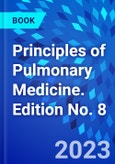-
Presents physiologic concepts, pathogenetic and pathophysiologic mechanisms, and radiologic and pathologic correlates of disease in a clear, understandable manner.�
-
Features extensive content updates on interstitial lung disease, emerging and/or viral infections (including COVID-19), lung cancer, asthma, and new biologic and immunologic treatments available for a variety of diseases.�
-
Contains excellent visuals for understanding and interpreting pulmonary disease with easy-to-understand anatomic illustrations and accompanying radiologic and pathophysiologic images-now all in full color for the first time. This edition provides even more images, especially chest radiographs and CT scans, that offer more examples of clinical disorders.��
-
Provides therapeutic strategies, including evidence for assessing relative benefits, harms, and costs.�
-
Includes useful appendices that provide simplified methods for interpreting pulmonary function tests and arterial blood gases, while also presenting sample problems that test the reader's ability to use respiratory equations, assess pulmonary function abnormalities, and interpret arterial blood gases.�
-
Provides access to extensive online content such as author commentaries, video clips, audio recordings of lung sounds, and over 200 case-based self-assessment questions modeled after the USMLE exam.�
-
Includes margin notes throughout the text that summarize the major points and concepts and allow the reader to quickly review the material.�
-
An eBook version is included with purchase. The eBook allows you to access all of the text, figures and references, with the ability to search, customize your content, make notes and highlights, and have content read aloud.�
Table of Contents
1 Pulmonary Anatomy and Physiology: The Basics2 Presentation of the Patient With Pulmonary Disease
3 Evaluation of the Patient With Pulmonary Disease
4 Anatomic and Physiologic Aspects of Airways
5 Asthma
6 Chronic Obstructive Pulmonary Disease
7 Miscellaneous Airway Diseases
8 Anatomic and Physiologic Aspects of the Pulmonary Parenchyma
9 Overview of Diffuse Parenchymal Lung Diseases
10 Diffuse Parenchymal Lung Diseases Associated With Known Etiologic Agents
11 Diffuse Parenchymal Lung Diseases of Unknown Etiology
12 Anatomic and Physiologic Aspects of the Pulmonary Vasculature
13 Pulmonary Embolism
14 Pulmonary Hypertension
15 Pleural Disease
16 Mediastinal Disease
17 Anatomic and Physiologic Aspects of Neural, Muscular, and Chest Wall Interactions With the Lungs
18 Disorders of Ventilatory Control
19 Disorders of the Respiratory Pump
20 Lung Cancer: Etiologic and Pathologic Aspects
21 Lung Cancer: Clinical Aspects
22 Lung Defense Mechanisms
23 Pneumonia
24 Bacterial and Viral Organisms Causing Pneumonia
25 Tuberculosis and Nontuberculous Mycobacteria
26 Miscellaneous Infections Caused by Fungi, Including Pneumocystis
27 Pulmonary Complications in the Immunocompromised Host
28 Classification and Pathophysiologic Aspects of Respiratory Failure
29 Acute Respiratory Distress Syndrome
30 Management of Respiratory Failure
Appendix A Sample Problems Using Respiratory Equations
Appendix B Pulmonary Function Tests: Guidelines for Interpretation and Sample Problems
Appendix C Arterial Blood Gases: Guidelines for Interpretation and Sample Problems
Index








